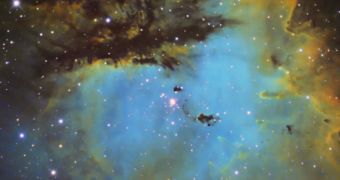In this photo submitted to Space, amateur astrophotographer Steve Coates, from Florida, captured the essence of the so-called Pac-Man Nebula, an H II region located in the constellation of Cassiopeia. The object, which measures around 49 light-years in diameter, is a part of the Perseus Arm in our galaxy.
An H II nebula is a region of space featuring low-density clouds of partially ionized gas. This is usually a sign that intense stellar formation has taken place recently at that location. The Pac-Man Nebula (also known as NGC 281), for example, includes the open star cluster IC 1590.
In this particular image, composed from data collected with different filters, the Pac-Man for which the object was named appears turned on its head. This nebula is included in the Sharpless catalog at number 184. This catalog provides a comprehensive view of H II regions in a certain portion of the sky.
E. E. Barnard was the first astronomer to discover the Pac-Man Nebula, back in August 1883. Shortly after, astronomer S. W. Burnham discovered a multiple star system called HD 5005, which features a massive primary star orbited by four smaller ones. Since 1875, this system has remained largely unchanged.

 14 DAY TRIAL //
14 DAY TRIAL //